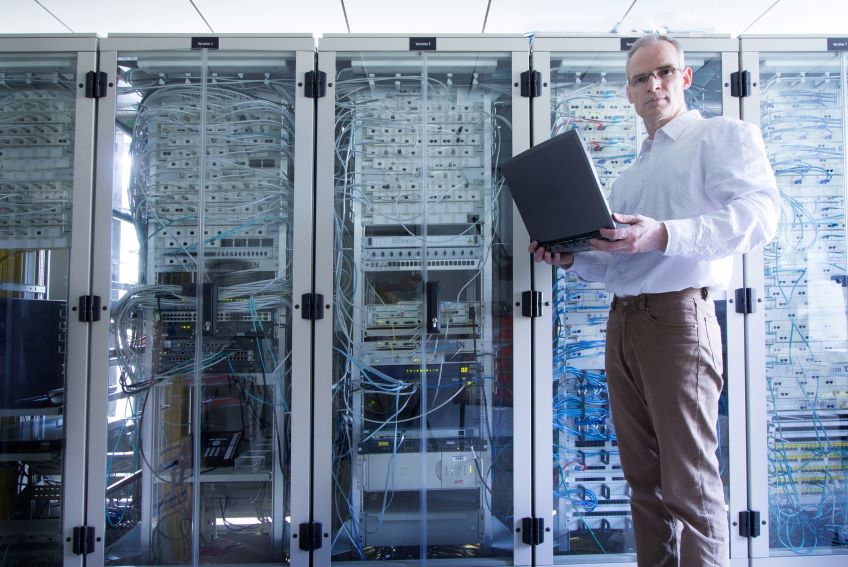Lumen Lede
Does The Network Matter More Than The Data Center?
By: Scott Brindamour

Where is business done? Does it happen between work colleagues at an office within a business park high-rise? Between a shopper and a salesperson at a brick-and-mortar shop in a retail strip? In a manufacturing plant on the outskirts of an industrial town? Sometimes. But these centralized, in-person interactions are far less common than they used to be. Now colleagues connect remotely over video calls. Shoppers browse and make retail purchases over their cell phones, expecting an experience as smooth and fast as an in-store interaction. A manufacturing facility manager talks face-to-face with a design engineer as they work through a thorny problem using augmented reality to review a multidimensional schematic.
The modern enterprise needs high bandwidth and low latency networks that process data closer to where it’s being created. More businesses are adopting edge strategies and investing in network infrastructure as their work becomes decentralized, shifting the burden away from the data center and closer to the edge.
What Is Edge Computing?
The rise of edge computing has changed how and where data is created, accessed and stored. The edge describes a distributed computing topology that moves both compute and storage infrastructure far closer to the creation point of data and its ultimate end users. Edge computing is driven by mobile devices, IoT, sensors, autonomous systems and so on. This decentralization makes network capabilities more critical than ever. Why? The exponential growth of networked devices, data sources, and users is driving network demand. Consider that by 2023, there will be 3.6 networked devices for every person on the planet. This high demand requires a more distributed network to free bandwidth, reduce latency and improve how quickly data can be processed and accessed, all while rethinking traditional data security.
Improving User Experience
Centralized data centers once made it easy to deliver optimal user experiences. They offered high availability, connectivity, and simplified management. However, these data centers resided on-premises and so too did the users of that data, who worked on PCs in an office environment. Now that compute and storage power have moved closer to the edge, and users carry computing power in their pockets, the approach to user experience must be different. Users still need availability and connectivity and administrators require simple management.
How do you achieve those user experience goals with decentralized networks?
- Adaptive networks let you scale on demand, giving your business the flexibility and agility to respond at ever increasing speeds to whatever the market and your users demand. This delivers low latency to your users, improving the experience at the point where the interaction between people and machines takes place.
- Better geographic reach improves availability and user connectivity, while software-defined networking (SDN) simplifies network management by providing dynamic management that is centralized and automated. That automation delivers better user experience by improving network speed performance as well as far more reliable up-time for your network.
- Dynamic connections allow you to link branch locations, while also automating scale. You can easily add or remove connections, just as they are needed. This ability to scale to meet real-time demand creates a seamless user experience that can match the experience that users require when they require it.
Investing In The Network
Both the network and the data center matter, but they are taking on different roles to accommodate the new reality of edge computing. This reality requires increased investment in network capacity and architecture. Part of meeting user demands means providing networks with global reach and scalable traffic capacity. This means greater focus on connectivity, redundancy, and load balancing.
- Connectivity: Connectivity is driven by robust links between parts of your network. This allows for easy connection to new locations, links to dispersed data centers and access to mission-critical cloud applications and storage. In fact, cloud connectivity is a mission-critical concern in today’s hybrid and multi-cloud environment.
- Redundancy: As networks decentralize, redundancy becomes more critical to prevent the lost revenue that results from unexpected downtime. You need alternate paths within your network to prevent points of failure and provide backup and recovery capabilities, which can be provided by globally dispersed, redundant networks.
- Load Balancing: Load balancing describes the ability to evenly and efficiently distribute traffic on a network. Load-balanced networks make the best use of available resources, improve availability of applications and minimize response times while routing around potential bottlenecks.
Your users demand speed and reliability when accessing data and applications. Investing in your network helps deliver the experience that your users and customers expect.
Moving Away From Data Center And Towards The Edge
Edge computing has made the concept of the traditional data center—centralized physical machines and data repositories—obsolete. Data centers may still be a critical part of your network, but they are no longer the centerpiece of it. Rather than relying on a centralized location, enterprises now find themselves building something more akin to a mobile/cell network, a mesh architecture that spans geographies and expands and contracts based on need and use.
The edge is now where your business happens. Is your network ready to handle the modern workloads that demand high bandwidth and low latency for processing at the edge?
About the author:
Scott Brindamour is a technology & thought leader with 20 years of experience in linking leading technologies to client’s business needs. Scott currently leads a team of client facing pre-sales architects across the US who develop complex hosting, network & cloud solutions that enable clients transform their business through the adoption of key technologies and the “best execution venue”. Scott’s key areas of focus are the modernization of the data center, the cloud adoption lifecycle and enabling Digital Transformation.












